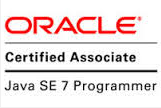This page is regularly updated with latest information on OCAJP exam and provides comprehensive details about the Oracle Certified Associate Java Programmer Exam 1. If you are not finding the information which you are looking for or if you want to purchases certification exam kit, please feel free to send a mail at [email protected]. What …
Certifications
OCMJEA 6 Syllabus
Application Design Concepts and Principles Identify the effects of an object-oriented approach to system design including the effect of encapsulation, inheritance, and use of interfaces. Identify how the Separation of Concerns principle applies to the component model of a Java EE application; including client, the web and business component containers, and the integration and resource …
OCPJP 7 Syllabus
Java Class Design Use access modifiers: private, protected, and public Override methods Overload constructors and methods Use the instanceof operator and casting Use virtual method invocation Override the hashCode, equals, and toString methods from the Object class to improve the functionality of your class. Use package and import statements Advanced Class Design Identify when and …
OCPJBCD / SCBCD 5 Exam
OCPJBCD / SCBCD 5 Mock Exams: Mock Exam 1 Mock Exam 2 Mock Exam 3 Mock Exam 4 The Syllabus for the OCPJBCD / SCBCD 5 exam is : Section 1: EJB 3.0 Overview Identify the uses, benefits, and characteristics of Enterprise JavaBeans technology, for version 3.0 of the EJB specification. Identify the APIs that …
OCEJWCD 6 Exam
The OCEJWCD certification provides knowledge required to develop Java EE 6 Enterprise applications using JSP and Servlets. This exam covers major improvements in Java EE 6 like web fragments, asynchronous servlet, annotations to create servlet or filter, etc. The following are the list of topics covered as part of this certification exam. Introduction to Java …
OCEJWCD 6 Mock Exam – 7
1 . Consider the following code: Which of the following lines, when inserted at //1, will ensure that an IllegalStateException is NOT thrown? Choose the one below: res.clear(); res.empty(); res.remove(); if(!res.isCommitted()) if( res.getStatus() != res.COMMITTED) 2 . Which of the following statements are correct JSP directives? <%@ page %> <%! taglib uri=”http://www.abc.com/tags/util” prefix=”util” %> <% …
OCEJWCD 6 Mock Exam – 5
1 . Assume that the following header is present in a request sent to a servlet: What will be returned when the servlet code calls request.getHeader(“Accept”)? Choose the one below: A Header object containing, name as “Accept” and value as “image/gif” A Header object containing, name as “Accept” and value as “image/gif, image/jpeg, image/bmp” A …
OCEJWCD 6 Mock Exam – 4
1 . Consider the following web.xml code: Which of the following statements are correct? Choose the one below: The servlet code should use “manager” as a parameter in request.isUserInRole() method The servlet code can use “manager” or “supervisor” as a parameter in request.isUserInRole() method The servlet code should use”supervisor” as a parameter in request.isUserInRole() method …



